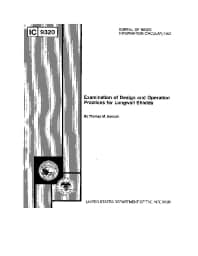Mining Publication: Examination of Design and Operation Practices for Longwall Shields
Original creation date: January 1992
Authors: TM Barczak
NIOSHTIC2 Number: 10011402
Pittsburgh, PA: U.S. Department of the Interior, Bureau of Mines, IC 9320, 1992 Jan; :1-14
The success of longwall mining can largely be traced to the development of powered roof support systems. The most significant improvement in powered support design has been the shield support, which improved kinematic stability and promoted the application of longwall mining in difficult-to-control caving conditions where chock and frame supports were inadequate. The most obvious trend in shield design has been an increase in shield size and capacity. This U.S. Bureau of Mines report examines shield design and operation practices and their consequences for the utilization of high-capacity shield support systems. An optimization goal is to minimize support loading by selecting an active shield setting force that is compatible with strata behavior and shield loading characteristics. Shield stiffness is an important design parameter that is often overlooked. A consequence of increasing shield capacity by incorporating larger diameter leg cylinders is a proportional increase in shield stiffness. Setting forces have also increased in direct proportion to the increase in shield capacity. The increased stiffness and higher setting force cause the available capacity to be consumed more quickly, severely limiting the ability of high-capacity supports to last longer and provide reserve capacity for difficult mining conditions.

NIOSHTIC2 Number: 10011402
Pittsburgh, PA: U.S. Department of the Interior, Bureau of Mines, IC 9320, 1992 Jan; :1-14
- Analysis and Design Considerations for Superimposed Longwall Gate Roads
- Behavior of Simulated Longwall Gob Material
- Controlling Respirable Dust in Coal Mining Operations
- Degasification System Selection for U.S. Longwall Mines Using an Expert Classification System
- History of the Mining Program
- Longwall Retreat of Gate Road Pillars
- Modeling and Prediction of Ventilation Methane Emissions of U.S. Longwall Mines Using Supervised Artificial Neural Networks
- Overview of Coal Mine Ground Control Issues in the Illinois Basin
- Pumpable Roof Supports: An Evolution in Longwall Roof Support Technology
- Technology News 430 - Translucent Face Partition Reduces Longwall Worker's Dust Exposure